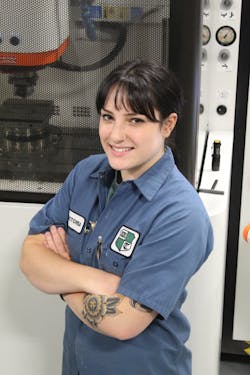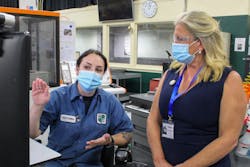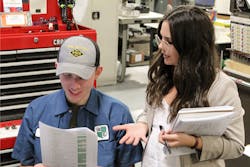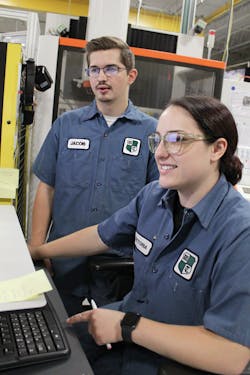Commitment to developing workers yields results for Westminster Tool
Join us for a webinar, "Developing and Retaining Your Skilled Talent," at noon Nov. 16, featuring Hannah Coombs, talent development manager at Westminster Tool in Plainfield, Conn., and Ben Waterman, business development manager at Monoflo International in Winchester, Va.
By Karen Hanna
As a teenager, Victoria Rooke found her calling amid the gleaming, high-tech equipment at Westminster Tool.
But, when it came to showing her academic bona fides for working the machines, she whiffed.
It didn’t matter. Westminster Tool, Plainfield, Conn., rewarded her for her desire, and now, at 23, she’s among the company’s brightest stars, as the head of a seven-person team responsible for the mold maker’s CNC machines.
For her, the journey began in high school.
“I had no manufacturing experience, and it was six years ago, I sat in the conference room with [company President and owner Ray Coombs], and he gave me an interview. It was my first-ever job interview,” Rooke said. “He gave me a math test and a machinist’s tools test, and I failed both of those.”
From that baseline, she’s continued to learn every day.
A yearslong transformation in how it evaluates candidates and employees has led Westminster Tool to some surprising results — with a labor force that includes more women than your average shop. Of its 37 workers, 14 are women, including Rooke. Many — about seven in 10 — start at Westminster Tool with no prior technical or manufacturing background.
Talent development manager Hannah Coombs said she believes her company’s decision over about the last 10 years to screen candidates based on their interests, rather than their experience, has made a tremendous impact. Since it adopted an approach that emphasizes growth and cross-training, it’s had better luck both finding people to fill positions and developing workers who can master multiple roles.
“Our first mission was to create a workplace that people want to work at. That was the first thing is creating a positive environment,” Coombs said. “The second thing is we completely abandoned searching for skillsets as part of our recruitment strategy. We had traditionally, like most manufacturers, looked for people with a certain job experience before hiring them. We were looking at their resumes; we were looking at their technical experience, any certifications, or apprenticeships. We stopped doing that. We said, ‘We're going to hire for character, not for skill. We’re going to train for skill.’ ”
The company has identified four traits it values above all others. People who will fit in and thrive have integrity and are dynamic, motivated and curious, Coombs said.
As long as its workers exhibit those characteristics, Westminster Tool is willing to teach them anything else they need.
“We [can] say, ‘We’ll take anybody regardless of your background, regardless of your age, regardless of your experience, we’ll bring you in, and we’ll train you on what you are passionate about, or what you’re interested in,’ ” Coombs said. “Just by doing that, by eliminating the search for skill exclusively, we opened up a huge window to the talent pool. Suddenly, we started having young people and older people and women who had zero background in manufacturing, saying, ‘Well, I can do that. That sounds OK.’ ”
The efforts show up in Westminster Tool’s demographics, which reveal a workforce that’s younger and more evenly split among men and women than the average workplace.
While women comprise about 38 percent of the company’s workforce, nationally, they make up only a sliver of the people employed as cutting, punching and press machine setters, operators, tenders and other metal and plastic workers — about 22 percent, according to data from the U.S. Bureau of Labor Statistics (BLS).
Westminster Tool’s workers also skew younger, with an average age of 35; BLS data show more than two-thirds of the U.S. workforce is at least that old.
“By changing the way that we recruit, we opened ourselves up to getting more diversity in the shop,” Coombs said.
Introduction to tool making
When Rooke first came to Westminster Tool, she’d never worked in manufacturing, but she had experience with tools.
The daughter of a mechanic, she loved riding dirt bikes and learning from her dad how to fix things. She was a student at a technical high school, on track to work with cars, when, she said, she “just kind of fell out of love with it.”
She started taking stock of what else was available — a process that eventually led her to Westminster Tool.
“I just hadn’t realized how cool it is,” Rooke said. “I kept having to go into the manufacturing shop and see people making stuff out of steel, and I just was completely mesmerized by that.”
After taking an introductory class covering blueprint-reading at Quinebaug Valley Community College (QVCC), she was eligible to gain real-world experience as part of a work-study program. That’s when she met Ray Coombs.
Westminster Tool extended an offer, Rooke said, “I think because he saw that I was super-driven. I was trying to pave my path for my future.”
She started in an area known as The Box — a training environment where new employees learn the culture and get exposure to manufacturing at their own pace.
“Every single new hire, whether you’re coming in for an executive position, or you’re coming in for entry level, goes through what we call The Box. In this production environment, they’re learning basic manufacturing skills, like blueprint reading, inspection, work holding, part setup,” said Hannah Coombs, who as the company owner’s daughter went through the training herself, just as other family members have.
While The Box is devoted to Westminster Tool’s aerospace business, the tolerances it requires aren’t as tight as elsewhere throughout the roughly 12,000-square-foot facility. It’s a slower pace, where new employees learn the ropes and Westminster Tool figures out what they might want to do next.
“It’s also a low-risk area where we determine what their natural abilities are. So, if somebody, say, has super, natural abilities with software, we might give them an opportunity to shadow a different department, say, in design,” Coombs said.
With many of its workers coming onboard with no experience, Westminster Tool has nurtured a number of partnerships and training opportunities, including manufacturing pipelines offered by QVCC and other community colleges, she said. The company’s long list of partners includes high schools, an elementary school makerspace program, the Eastern Advanced Manufacturing Alliance, Connecticut Manufacturing Pipeline Initiative and Connecticut Youth Manufacturing Pipeline Initiative.
Rooke is the graduate of one such path — after getting her degree from Windham Technical High School in Willimantic, Conn., she collected a nine-month certificate from nearby QVCC, courtesy of Westminster Tool, which paid for her advanced manufacturing training.
“We fund that for employees who express an interest, and we think it might be valuable,” Coombs said. “We lean on external training resources a ton. And that’s one of the ways that we can afford to, and we can successfully, onboard somebody who has zero skills.”
With millions of manufacturing jobs projected to lie fallow in the decades to come, Westminster Tool’s commitment to education could provide a template for other companies.
Training programs, partnerships and efforts that expose youth to manufacturing are all critical to drawing more people into fields such as mold making, said Bill Padnos, the executive director of the National Tooling and Machining Association (NTMA) Foundation.
Companies, he said, “have to understand that, if they can manufacture a part, they can manufacture a machinist.”
An association of 1,200 tool and die and precision manufacturing companies, the NTMA promotes apprenticeships. It’s been battling a familiar foe since its establishment in the World War II era.
“We were founded in 1943,” Padnos said, “because a group of manufacturing leaders in the precision metalworking industry got together and said, ‘We’ve got to figure out what’s going on because we have a skilled labor shortage.’ ”
As of August, when the most current numbers were released, durable-goods manufacturing accounted for 560,000 open positions, according to the BLS. Around the same time, of the NTMA’s members, 97 percent had at least one open, skilled position — a costly deficit, considering most of the shops employ just 40 or fewer people, Padnos said.
Apprenticeships create workers who not only have skills, but loyalty, Padnos said. While only about 30 percent of Gen Z and millennial workers are apt to stick with a job at a manufacturer after three years, more than 90 percent of former apprentices are still with their employer five years later.
“Workforce development and the issue of having a skilled labor [force], that’s a business strategy,” he said.
Here to stay
The opportunity to continue to learn is one thing Rooke said she loves about Westminster Tool. At some point, the EDM machinist said, she might look into project management.
But, for now, she’s still growing into her role as leader of the CNC group — which includes some people who are significantly older.
“She has risen in the company a lot. We call her one of our champions,” Hannah Coombs said.
With the right attitude, and the willingness to learn, Rooke said she has seen others at Westminster Tool thrive, too.
“I’m not satisfied with just sitting and doing one thing for the rest of my life. I just want as much experience, as much exposure, as I can get in this industry,” she said. “A lot of what made me want to become a leader here … is we have people coming in, customers, and I get to talk to so many different types of people, and it’s just inspiring hearing other people’s stories of how they got in the position that they are. And I guess I’m on that same path, of just climbing the ladder and taking every opportunity as it comes. And I probably won’t stop ever.”
About the Author
Karen Hanna
Senior Staff Reporter
Senior Staff Reporter Karen Hanna covers injection molding, molds and tooling, processors, workforce and other topics, and writes features including In Other Words and Problem Solved for Plastics Machinery & Manufacturing, Plastics Recycling and The Journal of Blow Molding. She has more than 15 years of experience in daily and magazine journalism.




